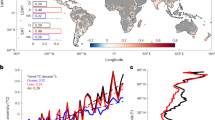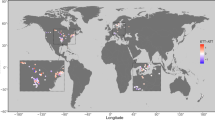Abstract
We estimate the effects of climatic changes, as predicted by six climate models, on lake surface temperatures on a global scale, using the lake surface equilibrium temperature as a proxy. We evaluate interactions between different forcing variables, the sensitivity of lake surface temperatures to these variables, as well as differences between climate zones. Lake surface equilibrium temperatures are predicted to increase by 70 to 85 % of the increase in air temperatures. On average, air temperature is the main driver for changes in lake surface temperatures, and its effect is reduced by ~10 % by changes in other meteorological variables. However, the contribution of these other variables to the variance is ~40 % of that of air temperature, and their effects can be important at specific locations. The warming increases the importance of longwave radiation and evaporation for the lake surface heat balance compared to shortwave radiation and convective heat fluxes. We discuss the consequences of our findings for the design and evaluation of different types of studies on climate change effects on lakes.





Similar content being viewed by others
References
Adrian R, O’Reilly CM, Zagarese H et al (2009) Lakes as sentinels of climate change. Limnol Oceanogr 54:2283–2297
Austin JA, Allen J (2011) Sensitivity of summer Lake Superior thermal structure to meteorological forcing. Limnol Oceanogr 56:1141–1154
Bogan T, Mohseni O, Stefan HG (2003) Stream temperature-equilibrium temperature relationship. Water Resour Res 39:1245
Coats R, Perez-Losada J, Schladow G, Richards R, Goldman C (2006) The warming of Lake Tahoe. Clim Chang 76:121–148
Desai AR, Austin JA, Bennington V, McKinley GA (2009) Stronger winds over a large lake in response to weakening air-to-lake temperature gradient. Nat Geosci 2:855–858
Edinger JE, Duttweiler DW, Geyer JC (1968) The response of water temperatures to meteorological conditions. Water Resour Res 4:1137–1143
Eggermont H, Heiri O, Russell J, Vuille M, Audenaert L, Verschuren D (2010) Paleotemperature reconstruction in tropical Africa using fossil Chironomidae (Insecta: Diptera). J Paleolimnol 43:413–435
Fang X, Stefan H (2009) Simulations of climate effects on water temperature, dissolved oxygen, and ice and snow covers in lakes of the contiguous United States under past and future climate scenarios. Limnol Oceanogr 54:2359–2370
George G (ed) (2010) The impact of climate change on European lakes. Aquat Ecol Ser 4, Springer, Dordrecht, 507 pp
Henderson-Sellers B (1986) Calculating the surface energy balance for lake and reservoir modeling: a review. Rev Geophys 24:625–649
Hondzo M, Stefan H (1993) Regional water temperature characteristics of lakes subjected to climate change. Clim Chang 24:187–211
Houser JN (2006) Water color affects the stratification, surface temperature, heat content, and mean epilimnetic irradiance of small lakes. Can J Fish Aquat Sci 63:2447–2455
IPCC (2007) Climate Change 2007: The Physical Science Basis. Contribution of Working Group I to the Fourth Assessment Report of the IPCC. Cambridge University Press, Cambridge
Jeppesen E, Mehner T, Winfield IJ et al (2012) Impacts of climate warming on the long-term dynamics of key fish species in 24 European lakes. Hydrobiologia 694:1–39
Karlsson J, Jonsson A, Jansson M (2005) Productivity of high-altitude lakes: climate effect inferred from altitude gradient. Glob Chang Biol 11:710–715
Knutti R (2008) Should we believe model predictions of future climate change? Phil Trans R Soc A 366:4647–4664
Komatsu E, Fukushima T, Harasawa H (2007) A modeling approach to forecast the effect of long-term climate change on lake water quality. Ecol Model 209:351–366
Kottek M, Grieser J, Beck C, Rudolf B, Rubel F (2006) World Map of the Köppen-Geiger climate classification updated. Meteorol Z 15:259–263
Lehner B, Döll P (2004) Development and validation of a global database of lakes, reservoirs and wetlands. J Hydrol 296:1–22
Livingstone DM (2003) Impact of secular climate change on the thermal structure of a large temperate central European lake. Clim Chang 57:205–225
Livingstone DM (2008) A change of climate provokes a change of paradigm: taking leave of two tacit assumptions about physical lake forcing. Int Rev Hydrobiol 93:404–414
Livingstone DM, Imboden DM (1989) Annual heat balance and equilibrium temperature of Lake Aegeri, Switzerland. Aquat Sci 51:351–369
Livingstone DM, Lotter AF (1998) The relationship between air and water temperatures in lakes of the Swiss Plateau: a case study with palaeolimnological implications. J Paleolimnol 19:181–198
Livingstone DM, Lotter AF, Kettle H (2005) Altitude-dependent differences in the primary physical response of mountain lakes to climatic forcing. Limnol Oceanogr 50:1313–1325
Livingstone DM, Adrian R, Arvola L et al (2010) Regional and supra-regional coherence in limnological variables. In: George G (ed) The impact of climate change on European Lakes. Springer, Dordrecht, pp 311–337
Loomis SE, Russell JM, Ladd B, Street-Perrot FA, Sinninghe Damsté JS (2012) Calibration and application of the branched GDGT temperature proxy on East African lake sediments. Earth Planet Sci Lett 357–358:277–288
Martynov A, Sushama L, Laprise R (2010) Simulation of temperate freezing lakes by one-dimensional lake models: performance assessment for interactive coupling with regional climate models. Boreal Environ Res 15:143–164
Matzinger A, Schmid M, Veljanoska-Sarafiloska E, Patceva S, Guseska D, Wagner B, Müller B, Sturm M, Wüest A (2007) Eutrophication of ancient Lake Ohrid: global warming amplifies detrimental effects of increased nutrient inputs. Limnol Oceanogr 52:338–353
Meehl GA, Covey C, Delworth T, Latif M, McAvaney B, Mitchell JFB, Stouffer RJ, Taylor KE (2007) The WCRP CMIP3 multimodel dataset: a new era in climate change research. Bull Am Meteorol Soc 88:1383–1394
Paerl HW, Paul VJ (2012) Climate change: links to global expansion of harmful cyanobacteria. Water Res 46:1349–1363
Peeters F, Livingstone DM, Goudsmit G-H, Kipfer R, Forster R (2002) Modeling 50 years of historical temperature profiles in a large central European lake. Limnol Oceanogr 47:186–197
Rimmer A, Gal G, Opher T, Lechinsky Y, Yacobi YZ (2011) Mechanisms of long-term variations in the thermal structure of a warm lake. Limnol Oceanogr 56:974–988
Rinke K, Yeates P, Rothhaupt K-O (2010) A simulation study of the feedback of phytoplankton on thermal structure via light extinction. Freshw Biol 55:1674–1693
Robertson DM, Ragotzkie RA (1990) Changes in the thermal structure of moderate to large sized lakes in response to changes in air temperatures. Aquat Sci 52:360–380
Schneider P, Hook SJ (2010) Space observations of inland water bodies show rapid surface warming since 1985. Geophys Res Lett 37, L22405
Shimoda Y, Azim ME, Perhar G, Ramin M, Kenney MA, Sadraddini S, Gudimov A, Arhonditsis GB (2011) Our current understanding of lake ecosystem response to climate change: what have we really learned from the north temperate deep lakes? J Great Lakes Res 37:173–193
Stefan HG, Hondzo M, Fang X, Eaton JG, McCormick JH (1996) Simulated long-term temperature and dissolved oxygen characteristics of lakes in the north-central United States and associated fish habitat limits. Limnol Oceanogr 41:1124–1135
Stefan HG, Fang X, Hondzo M (1998) Simulated climate change effects on year-round water temperatures in temperate zone lakes. Clim Chang 40:547–576
Straile D, Jöhnk K, Rossknecht H (2003) Complex effects of winter warming on the physicochemical characteristics of a deep lake. Limnol Oceanogr 48:1432–1438
Trolle D, Hamilton DP, Pilditch CA, Duggan IC, Jeppesen E (2011) Predicting the effects of climate change on trophic status of three morphologically varying lakes: implications for lake restoration and management. Environ Model Softw 26:354–370
van Vliet MTH, Ludwig F, Zwolsman JJG, Weedon GP, Kabat P (2011) Global river temperatures and sensitivity to atmospheric warming and changes in river flow. Water Resour Res 47, W02544
Verburg P, Hecky RE (2009) The physics of the warming of Lake Tanganyika by climate change. Limnol Oceanogr 54:2418–2430
Verschuren D (2003) Lake-based climate reconstruction in Africa: progress and challenges. Hydrobiologia 500:315–330
Weyhenmeyer GA (2008) Water chemical changes along a latitudinal gradient in relation to climate and atmospheric deposition. Clim Chang 88:199–208
Weyhenmeyer GA, Livingstone DM, Meili M, Jensen O, Benson B, Magnuson JJ (2011) Large geographical differences in the sensitivity of ice-covered lakes and rivers in the Northern Hemisphere to temperature changes. Glob Chang Biol 17:268–275
Wilhelm S, Hintze T, Livingstone DM, Adrian R (2006) Long-term response of daily epilimnetic temperature extrema to climate forcing. Can J Fish Aquat Sci 63:2467–2477
Winder M, Schindler DE (2004) Climate change uncouples trophic interactions in an aquatic ecosystem. Ecology 85:2100–2106
Winder M, Sommer U (2012) Phytoplankton response to a changing climate. Hydrobiologia 698:5–16
Yokohata T, Emori S, Nozawa T et al (2008) Comparison of equilibrium and transient responses to CO2 increase in eight state-of-the-art climate models. Tellus 60A:946–961
Acknowledgments
We acknowledge the modeling groups, the Program for Climate Model Diagnosis and Intercomparison (PCMDI) and the WCRP’s Working Group on Coupled Modelling (WGCM) for their roles in making available the WCRP’s CMIP3 multi-model dataset. Support of this dataset is provided by the Office of Science, U.S. Department of Energy. We thank John C. Little for contributing to the literature review, David M. Livingstone and Andy F. Lotter for reviewing a previous version of this manuscript, and B. Henderson-Sellers and three anonymous reviewers for their constructive comments.
Author information
Authors and Affiliations
Corresponding author
Electronic supplementary material
Below is the link to the electronic supplementary material.
ESM 1
(PDF 347 kb)
Rights and permissions
About this article
Cite this article
Schmid, M., Hunziker, S. & Wüest, A. Lake surface temperatures in a changing climate: a global sensitivity analysis. Climatic Change 124, 301–315 (2014). https://doi.org/10.1007/s10584-014-1087-2
Received:
Accepted:
Published:
Issue Date:
DOI: https://doi.org/10.1007/s10584-014-1087-2




